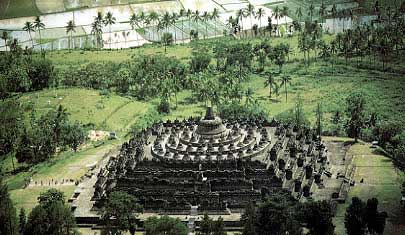
Buddhist marvel of stone standing in the garden of Java, Indonesia
The Borobodur Temple complex is one of the greatest monuments in the world. It is of uncertain age, but thought to have been built between the end of the seventh and beginning of the eighth century A.D. For about a century and a half it was the spiritual centre of Buddhism in Java, then it was lost until its rediscovery in the eighteenth century.
The structure, composed of 55,000 square meters of lava-rock is erected on a hill in the form of a stepped-pyramid of six rectangular storeys, three circular terraces and a central stupa forming the summit. The whole structure is in the form of a lotus, the sacred flower of Buddha.

For each direction there are ninety-two Dhyani Buddha statues and 1,460 relief scenes. The lowest level has 160 reliefs depicting cause and effect; the middle level contains various stories of the Buddha's life from the Jataka Tales; the highest level has no reliefs or decorations whatsoever but has a balcony, square in shape with round walls: a circle without beginning or end. Here is the place of the ninety-two Vajrasattvas or Dhyani Buddhas tucked into small stupas. Each of these statues has a mudra (hand gesture) indicating one of the five directions: east, with the mudra of calling the earth to witness; south, with the hand position of blessing; west, with the gesture of meditation; north, the mudra of fearlessness; and the centre with the gesture of teaching.

Devotional practice of circumambulate around the galleries and terraces.
Besides being the highest symbol of Buddhism, the Borobodur stupa is also a replica of the universe. It symbolises the micro-cosmos, which is divided into three levels, in which man's world of desire is influenced by negative impulses; the middle level, the world in which man has control of his negative impulses and uses his positive impulses; the highest level, in which the world of man is no longer bounded by physical and worldly ancient desire.
It is devotional practice to circumambulate around the galleries and terraces always turning to the left and keeping the edifice to the right while either chanting or meditating. In total, Borobodur represents the ten levels of a Bodhisattva's life which he or she must develop to become a Buddha or an awakened one.
The extraordinary cultural heritage of Central Java
A lush tropical landscape dotted with hundreds of archeological temples, including two UNESCO world heritage sites, Borobudur and Prambanan, this is a destination that leaves you spellbound. The grandeur and complexity of the temples has to be seen to be believed, and photography struggles to convey the depth. 

At a time when Europe was still in the dark ages, the “Central Javanese Period“ was building religious structures and art, now recognised as being the oldest and highest level of art within South East Asia
Central Javanese spirituality and artistic endeavour continues to exist side by side with mundanities of every day life.
Borobudur, Prambanan and Ratu Boko
The extraordinary cultural heritage of Central Java
A lush tropical landscape dotted with hundreds of archeological temples, including two UNESCO world heritage sites, Borobudur and Prambanan, this is a destination that leaves you spellbound. The grandeur and complexity of the temples has to be seen to be believed, and photography struggles to convey the depth. 

At a time when Europe was still in the dark ages, the “Central Javanese Period“ was building religious structures and art, now recognised as being the oldest and highest level of art within South East Asia
Central Javanese spirituality and artistic endeavour continues to exist side by side with mundanities of every day life.
A brief history
At the time in which these monuments were built, Indian pilgrims had spread Buddhist and Hindu teachings spread across Java, Indonesia. The proud ruling dynasties of Central Java built a seemingly endless number of structures, of all scales.
Buddhist and Hindu religions lived harmoniously side by side across Java, and as families of different religions married, even mixed religion temples were built.
The adaption of Indian religion and customs with the local artistry and traditions bred its own unique style; “Hindu-Java Art” .
Around 920 the power shifted from Central Java to West Java and the monuments including Borobudur, Prambanan and Ratu Boko became neglected, exposed to ash from volcanic eruptions, and the ravages of the local vegetation.
Now restoration sees these world relevant sites back on the map with millions of people visiting each year.
By car from Yogyakarta :
Prambanan is around 30 minutes driveBorobudur is approximately 40 minutes away
Ratu Boko is close to 35 minutes drive
sumber : http://www.buddhanet.net/boro.htm
http://www.borobudurpark.co.id/

0 comments:
Post a Comment